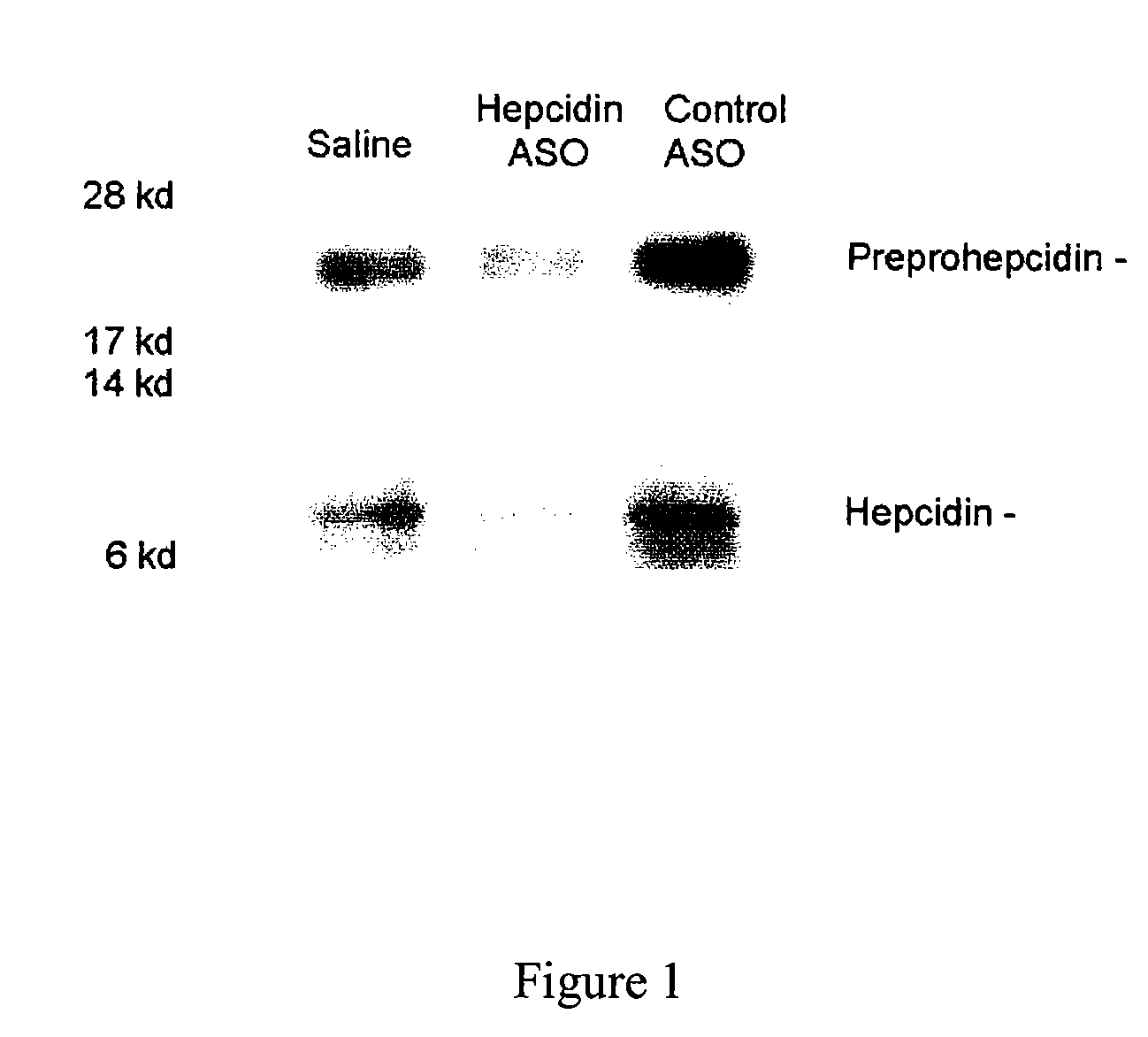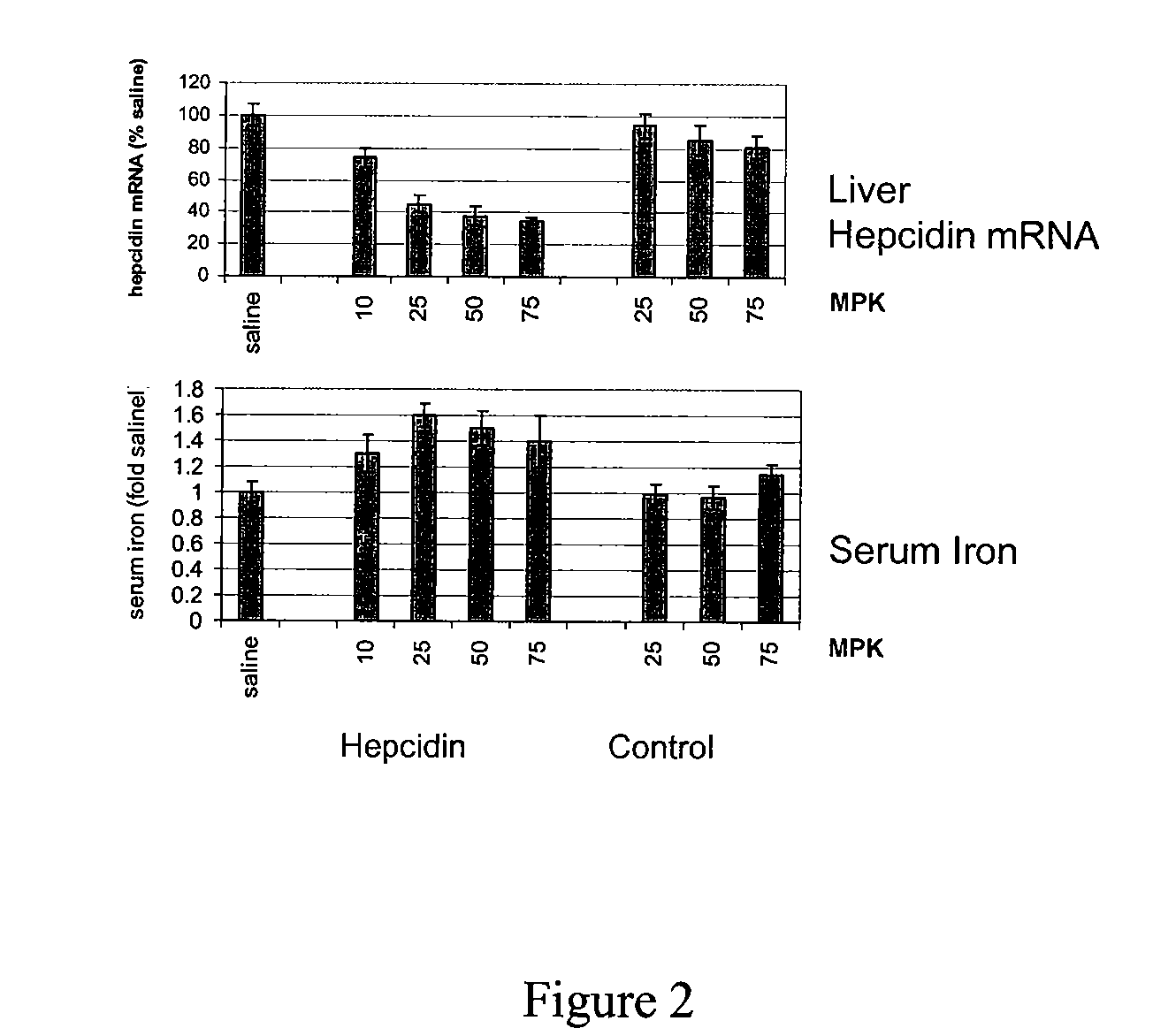Compositions and their uses directed to hepcidin
a technology of compositions and hepcidin, applied in the field of hepcidin, can solve the problems of reducing the production of erythrocytes (red blood cells), limiting the use of chemotherapeutic agents during cancer treatment, fatigue, and pallor
- Summary
- Abstract
- Description
- Claims
- Application Information
AI Technical Summary
Benefits of technology
Problems solved by technology
Method used
Image
Examples
example 1
Cell Types and Transfection Methods
[0089] The effect of oligomeric compounds on target nucleic acid expression was tested on the following cell types.
[0090] Mouse Primary Hepatocytes: Primary mouse hepatocytes were prepared from CD-1 mice purchased from Charles River Labs (Wilmington, Mass.). Primary mouse hepatocytes were routinely cultured in Hepatocyte Attachment Media supplemented with 10% fetal bovine serum, 1% penicillin / streptomycin (both from Sigma-Aldrich, St. Louis, Mo.), 1% antibiotic-antimitotic (Invitrogen Life Technologies, Carlsbad, Calif.) and 10 nM bovine insulin (Sigma-Aldrich, St. Louis, Mo.). Cells were seeded into 96-well plates (Falcon-Primaria #3872) coated with 0.1 mg / ml collagen at a density of approximately 10,000 cells / well for use in oligomeric compound transfection experiments.
[0091] HepG2: The human hepatocarcinoma cell line was obtained from the American Type Culture Collection (Manassas, Va.). HepG2 cells were routinely cultured in minimum essentia...
example 2
Real-Time Quantitative PCR Analysis of Hepcidin mRNA Levels
[0095] Quantitation of hepcidin mRNA levels was accomplished by real-time quantitative PCR using the ABI PRISM™ 7600, 7700, or 7900 Sequence Detection System (PE-Applied Biosystems, Foster City, Calif.) according to manufacturer's instructions.
[0096] Prior to quantitative PCR analysis, primer-probe sets specific to the hepcidin being measured were evaluated for their ability to be “multiplexed” with a GAPDH amplification reaction. After isolation the RNA was subjected to sequential reverse transcriptase (RT) reaction and real-time PCR, both of which were performed in the same well. RT and PCR reagents were obtained from Invitrogen Life Technologies (Carlsbad, Calif.). RT, real-time PCR was carried out in the same by adding 20.micro.L PCR cocktail (2.5×PCR buffer minus MgCl.sub.2, 6.6 mM MgCl.sub.2, 375.micro.M each of DATP, dCTP, dCTP and dGTP, 375 nM each of forward primer and reverse primer, 125 nM of probe, 4 Units RNAs...
example 3
Antisense Reduction of Human Hepcidin Expression by Oligomeric Compounds
[0101] A series of antisense oligonucleotide compounds was designed to target different regions of human hepcidin RNA, using published sequences or portions of published sequences as cited in Table 1. The compounds are shown in Table 3. Methods for designing and testing antisense oligonucleotides for reduction of mRNA target expression are discussed herein and well known to those skilled in the art. Although an antisense oligonucleotide is reported in Table 3 as being targeted to a particular sequence, one ordinarily skilled in the art will know that these sequences may also target other sequences. For example, in Table 3 SEQ ID NO: 50 is reportedly designed to target nucleotides 261 to 280 of SEQ ID NO: 2. However, SEQ ID NO: 50 is also fully complementary to nucleotides 486 to 505 of SEQ ID NO: 1 and nucleotides 4662 to 4681 of SEQ ID NO: 3.
[0102] The compounds were analyzed for their effect on target mRNA l...
PUM
| Property | Measurement | Unit |
|---|---|---|
| density | aaaaa | aaaaa |
| pH | aaaaa | aaaaa |
| time | aaaaa | aaaaa |
Abstract
Description
Claims
Application Information
 Login to View More
Login to View More - R&D
- Intellectual Property
- Life Sciences
- Materials
- Tech Scout
- Unparalleled Data Quality
- Higher Quality Content
- 60% Fewer Hallucinations
Browse by: Latest US Patents, China's latest patents, Technical Efficacy Thesaurus, Application Domain, Technology Topic, Popular Technical Reports.
© 2025 PatSnap. All rights reserved.Legal|Privacy policy|Modern Slavery Act Transparency Statement|Sitemap|About US| Contact US: help@patsnap.com



